
Head Surgery Page Menu: 1 2 3 4 5 6 7 8 9 10 11 12 13 14 Next>>
Head Surgery During the Golden Age of Piracy, Page 13
Head Wound Post-Op: Healing the Wound Edges
Whether the skin of the scalp was cut to allow easier access to the wound or whether the skin was torn when wounded, medicating the severed edges of a head wound encouraged healing. Richard Wiseman advised applying a digestive medicine - that is one that promoted the generation of tissue. His prescription for this purpose:
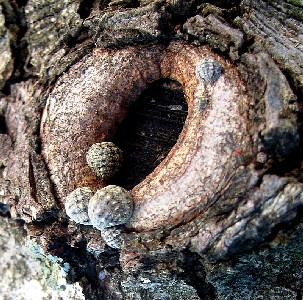
Photo: M. Spodek & Y. Ben-Dov
Kermes Echinatus Bugs (Used to Make Red Dye) on Tree Trunk
Rx Terebinth. Venet. [Venetian Turpentine] {1 dram} ol. ros. [Oil of Roses] {4 drams} mell. Ros. [Honey of Roses] {dram} croci [Saffron] {1 scruple} Granor[um] Kermes [a red dye extracted from Kermes Echinatus bugs] {1/2 dram} sem. hyperici [seeds of St. John's Wort] {2 scruples} Vini Hispanic. [Spanish Wine] {3 drams} coq ad consumpt. Vini [cook until the wine is consumed]; colat. [strain it] Adde aloes {1 ounce} Misc. [mix]1
The bulk of this concoction is Wiseman's old standby, oil of roses, believed to be valuable for treating head wounds. Saffron was similarly mentioned by sea surgeon John Woodall to be "good for the braine"2 and helping to build tissue. Turpentine had mild cleansing and wound healing properties. On top of this, Wiseman advised the surgeon to "apply empl. diapalmæ [Emplastrum Diapalma] malaxed [kneaded] with ol. ros. [oil of roses]."3 The diapalma plaster is a close relative of Emplastrum Dialchalciteos, which Wiseman used over the entire wound, as noted in the previous section. Both plasters were used to heal wounds.
In his case studies, sea surgeon John Moyle discusses two medicines for the 'lips of the wound'.
The first is a 'digestive Balsam' applied on 'Dossels [small rolls] of Lint': " Rx. Gum. Elem. [Gum Elemini - gum resin] {1/2 ounce} dissol. [dissolved] in Ol. Ros. [oil of roses] {1/2 ounce} Super ignem. Colat.{stir while heating]
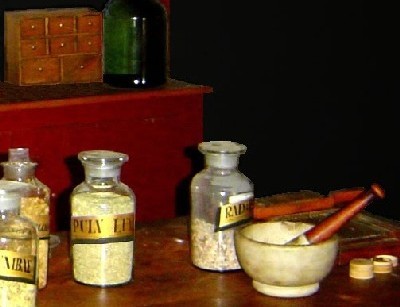
Adde. Tereb. Cipri. [Cypress Turpentine] {1 dram} misce. f. Balsam [make into a balsam]."4
The turpentine and oil of roses are similar to Wiseman's recommendation. Physician Nicholas Culpeper says that Gum Elemni "Is exceding good for Fractures of the Skull; as also in Wounds, and therefore is put in Plaisters for that end."5
Moyle finishes that by explaining that once the dossils were medicated with the balsam, "they were dipt in warm Ol. Lumbric. [Oil of Earthworms] and imposited."6 This oil was said to have anodyne ( pain relieving) properties.
In another case study, Moyle soaked the dossils to be applied to the edges of the wound in "Rx. Tereb. Ven. [Venice Turpentine] {3 ounces} Vitell. unius Ovi. [an egg yoke] Farin. Hord. [Barley Meal] {6 drams} Pulv. Thur. [Powdered Frankincense] {2 drams} misce. f. Bals. [make into a balsam]."7
This prescription is interesting in that it contains no rose-based ingredients. The egg and barley meal were both said to have wound-healing capabilities. Frankincense was likely applied because it "outwardly fills ulcers with flesh"8. After applying this to the dossils, Moyle says "they were dipped in warm Ol. Catallorum [Oil of Puppies], and so imposited."9 (What is it with Moyle and weird oils of animals?) Like oil of earthworms, oil of puppies was thought to be anodyne.
1 Richard Wiseman, Of Wounds, Severall Chirurgicall Treatises, 1676, p. 382; 2 John Woodall, the surgions mate, 1617, p. 12; 3 Wiseman, p. 382; 4 John Moyle, Memoirs: Of many Extraordinary Cures, 1708, p. 15; 5 Nicholas Culpeper, Pharmacopœia Londinesis, 1720, p. 45; 6 Moyle, p. 15; 7 Moyle, p. 4; 8 Samuel Frederick Gray, A Supplement to the Pharmacopoeia, 1821, p. 189; 9 Moyle, p. 4
Head Wound Post-Op: Healing Contusions of the Head
In addition to addressing the dressing of the fracture in the skull, trepanned holes and the edges of the wound, some of the surgeons from this period discussed treating contusions of the head. These were bruised areas which had not penetrated skull. They included standalone contusions as well as those which coincided with a skull fracture.
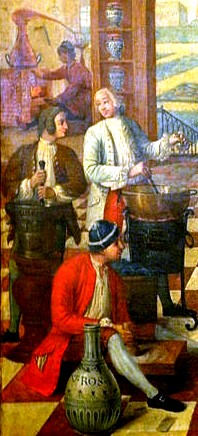
Artist: Michel-Carles Coquelet-Souville
Making Medicines, From Claude Morelot
In his Pharmacy (1751)
Sea surgeon John Woodall advised the use of the same medicines which he used to treat the dura mater. The first contained warm honey of roses and either oil of roses or syrup of roses. An alternative he suggested included honey, turpentine and an egg yolk. On top of these applications he recommended his standby for head wounds: Linamentum Arcæi.1
Fellow sea surgeon John Moyle mentions a medicine for contusions in one of his case studies where a sailor's skull had been badly fractured by another sailor with a crowbar. Moyle explains that after the fracture was dealt with, he used a 'discussive' plaster (one that would disperse unwanted matter) which was "spread thick on a double Linteum [linen cloth], and laid on, all over the contused Head."2 The recipe for this plaster was:
Rx. Farin. Hord. [barley meal] {8 ounces} Ol Rosar [oil of roses] {4 ounces} Pulv. flor. Ros. Rub.[powdered flower of red roses] {6 drams} Balaust. Bacc. [pomegranate fruit] Myrtill. [myrtle - probably the common myrtle berry] {of each 2 drams} in acet. Vin. [in wine vinegar] q. s. [as much as is needed] decoct. ad consistant. Cataplasmatis. [boiled down to the consistency of a cataplasm - another name for a plaster]3
The bulk of this prescription is made of barley and rose-based ingredients which have already been discussed. Both of the fruits were said to have astringent properties, so they were probably included to prevent bleeding or flows of other serums from the wound. Wine vinegar was noted to have dispersing properties.
1 John Woodall, the surgions mate, 1617, p. 135; 2,3 John Moyle, Memoirs: Of many Extraordinary Cures, 1708, p. 15
Head Wound Post-Op: Bandaging the Head
While many of the surgeons mention bandaging the head, only some provide detail on how this was done. For example, sea surgeon John Atkins makes an attempt to do so. He says,
The Head-Bandage is a double Rowler, the Ends of unequal Length, and beginning on the Forehead, you carry it behind; with the shortest End you pass backwards and forwards, till the whole Head is covered; and the longest constantly being round, binds at every Turn.1
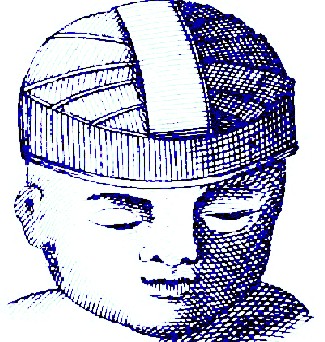
Head Bandaged with Roller, From A General System of
Surgery, by Lorenz Heister, Plate 38, (1743)
Admittedly, this description is far from clear, which may explain why most surgeons didn't comment on the bandaging technique - it was hard to describe. Atkins appears to be suggesting the roller bandage be placed on the forehead in a way that one side was longer than the other. The shorter end would be passed back and forth over the top of the head to cover it and then the longer side would be wound around the head in way that would secure the side covering the top.
This description is probably only marginally less confusing than Atkins' own. However, it probably looked like the bandage shown in the image at left. Bandaging techniques were most likely taught via apprenticeship for this very reason - they were easier to show a budding surgeon than to describe to him in a text.
John Moyle mentions a bandage in one of his case studies. After the patient's head had been operated on and medicated, "a folded Cloth was wrapped over it, and Cancer-bandage was made."2 Unfortunately, Moyle does not explain how a 'cancer bandage' was made or even what it looked like.
Fortunately, German surgeon Johannes Scultetus provides quite a bit of detail on the use of a cancer bandage with an explanatory image.
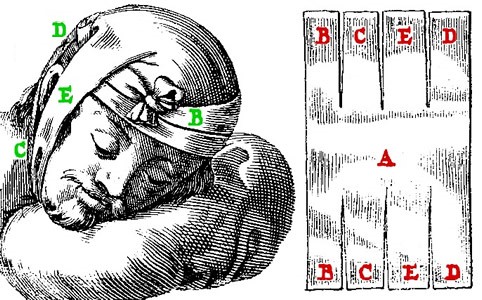
'Cancer' Bandage for the Head, from L'Arcenal de Chirurgerie by Johannes Scultetus, p. 108 (1653)
[This is] the band[age] called a cancer, which for wounds of the head is the best of all to contain them, and also the most commodious; broad in the middle (A) and on both sides have four ends; whereof two begin from the temples, and end in the hinder part of the head, where they must be sewed (D;) two arise from the hinder part of the head, and are bound together on the fore part of the head (B;) two are turned behind the ears (C,) and as many before them are fastned under the chin together.3
Like Atkins' description, this is only marginally helpful. Fortunately, he includes an image of the bandage on the patient's head along with further explanations. "1. The ends D are united behind the head. 2. C under the chin. 3. D. [this is a typo - he means B based on his previous statement] on the fore-part, above the fore-head. 4. E under the chin. Yet let the head be bound delicately, so that the band may hold fast, but not press it."4 While the text is still somewhat confusing (particularly because he mistakenly wrote 'D' when he meant 'B') the second image is helpful in understanding how the cancer bandage would work.
1 John Atkins, The Navy Surgeon, 1742, p. 87; 2 John Moyle, Memoirs: Of many Extraordinary Cures, 1708, p. 4; 3,4 Johannes Scultetus, The Chirurgeons storehouse, 1674, p. 110
Head Wound Post-Op: Keeping the Patient Comfortable
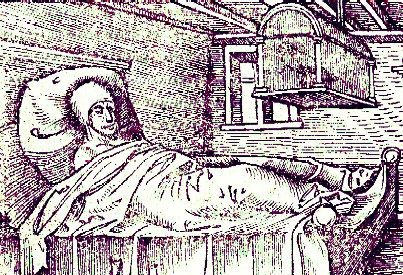
Ulrich von Hutten in Bed (16th century)
Once the wounded patient's head was dressed, the surgeon made efforts to keep the patient comfortable to encourage healing. Military surgeon Richard Wiseman says in one of his case studies that after the patient's head wound was dressed, he "laid him down in his Bed."1 The patient was no doubt placed in a warm room, since Wiseman is the surgeon who said that one of the difficulties a sea surgeon faced when healing a patient with a head wound was "lodging them or dressing them so warm as they require."2 A similar treatment was noted one of sea surgeon John Moyle's case studies, specifying that after trepanning "the Man was put to his Cabbin to rest"3.
French surgeon Pierre Dionis was most concerned with keeping the patient's head warm. He recommends using a "Woolen Cap V, which I put over the Bandage; for the Linen being put twice double on the Head, that
_Pierre_Dionis_1708.jpg)
Woolen Hat, from L'Arcenal de
Chirurgerie
by Johannes Scultetus, p. 108 (1653)
Part is not sufficiently defended from the Cold, considering, that being shorn, 'tis more sensible [sensitive to the cold]; wherefore this Cap is necessary to keep the Part warm."4 While he doesn't specifically say the patient should be put in bed like Wiseman, Dionis does suggest that patient be set "in a proper Posture; the best for the Patient is to lie on the Wound, in order, by that Declination, to help the Brain to thrust out whatever incommodes it."5
Sea surgeons were also concerned with the problem of keeping a patient with a head wound warm. Like Dionis sea surgeon John Atkins advises that the surgeon put "a Woolen Cap" over the bandaged head."6 (It probably wasn't quite in the style of the dainty bonnet that Dionis figures, however.)
Fellow sea surgeon John Woodall explained that the surgeon was to "keepe it [the head] likewise from cold, and of a temperate heat... The generall remedies for wounds of the head must neither overmuch refrigerate, nor overmuch calefie [warm], but be of a moderate or temperate calor [heat]."7
Woodall suggested keeping patients in the dark (in this case literally). He says that "it is good to keepe the party lying and in a darke place, till the greatest danger of accidents be past"8. However, Woodall quickly adds that the surgeon should remember "withal that the overstrickt keeping him in, may also be very offensive to the sicke."9 In one of his case studies, Richard Wiseman similarly notes that "we kept him [the patient] in the dark"10. Sea surgeon John Moyle advises that head wound patients "be kept at first as free from noise as possible, (but this is a hard thing to be observed in a Ship.)"11 Dionis told his student to advise the patient "to keep himself very still, and even to avoid speaking"12. These recommendations almost sound as if they are designed to either handle or prevent migraine headaches.
1 Richard Wiseman, Of Wounds, Severall Chirurgicall Treatises, 1676, p. 394; 2 Wiseman, p. 403; 3 John Moyle, Memoirs: Of many Extraordinary Cures, 1708, p. 3; 4,5 Pierre Dionis, A course of chirurgical operations: demonstrated in the royal garden at Paris. 2nd ed., p. 287; 6 John Atkins, The Navy Surgeon, 1742, p. 87; 7 John Woodall, the surgions mate, 1617, p. 135; 8 Woodall, p. 135-6; 9 Woodall, p. 136; 10 Wiseman, p. 392; 11 John Moyle, The Sea Chirurgeon, 1693, p. 114; 12 Dionis, p. 287

